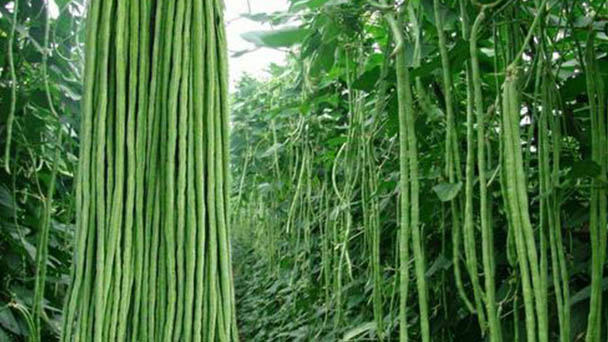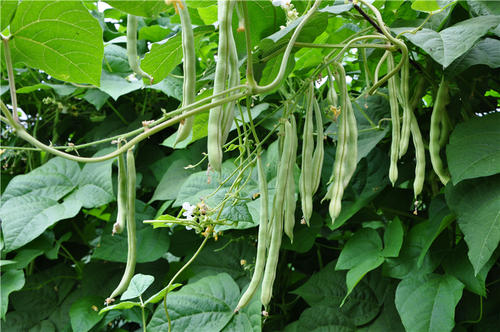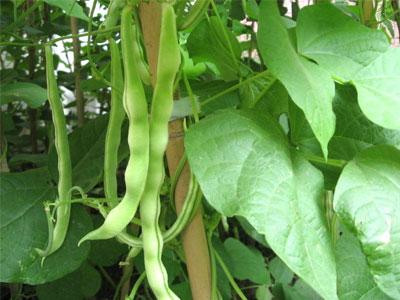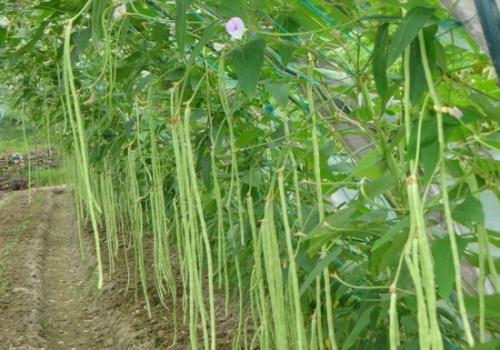Yardlong bean profile
Written by Maggie
Jan 28 2021

Yardlong bean, scientific name Vigna unguiculata, also called asparagus bean, is an annual vegetable belonging to the genus Yardlong bean of Rosa family. Rich in protein, carotene, high nutritional value and good taste, Yardlong bean is one of the popular vegetables widely cultivated in north China, and its popularity ranks first among all kinds of vegetables. Yardlong bean has strong adaptability. It can be cultivated in open or protected fields. It can also be produced annually and marketed in four seasons.
Yardlong bean picture

Yardlong bean characteris
Yardlong bean is an annual twining, herbaceous vines or suberect herbs, sometimes twining apically. Stem sub glabrous. Compound leaves are pinnate with 3-leaflets; Stipules are lanceolate, about 1 cm long, extending down into a short distance, wired;Leaflets ovate-rhomboid, 5-15 cm long, 4-6 cm wide, apex acute, margin entire or sub entire, sometimes lavender, glabrous. Racemes of yardlong bean are axillary, long pedunculate; Flowers are 2-6 clustered at apex of inflorescence, often fleshy dense glandular between pedicels; Calyx of yardlong bean is light green, campanulate, 6-10 mm long, lobed teeth lanceolate; Corolla is yellow white and slightly bluish, about 2 cm long, each valve with a stalk, flag valve flat round, about 2 cm wide, the top is slightly concave, the base of the ear, the wing valve is slightly triangular, keel valve slightly curved; Ovary of Yardlong bean is linear, hairy. Pod of Yardlong bean is pendulous, erect or obliquely spreading, linear, 7.5 -- 70 (90) cm long, 6 -- 10 mm wide, slightly fleshy and swollen or firm, with many seeds; Seeds are long elliptic or cylindrical.
Yardlong bean growing methods
Temperature
Yardlong beans are heat-resistant vegetables that can withstand high temperature and frost. According to the seed germination rate measurement conducted by Vegetable Research Institute of Chinese Academy of Agricultural Sciences, the suitable temperature for Yardlong bean seed germination was 25-35℃, and the germination rate and germination potential were the best at 35℃. Under 20℃, the germination is slow and the germination rate decreases, but under 15℃, the germination rate and germination potential are both poor. The seedlings of Yardlong bean were quickly unearthed at 30^35℃ after sowing. The vines grow better at 20-25℃ after pumping. Growth and pod formation can be achieved at a temperature of about 35℃. Yardlong bean growth was slow at about 15℃, growth was inhibited when the temperature was below 10℃ for a long time, and Yardlong bean was frozen when the temperature was close to 0℃.
Light
Long yardlong beans (pods over 30 cm long) are not strict on the length of sunshine. Yardlong bean is a light-loving crop, which needs good sunshine during flowering and pods. If the light is not enough, it will cause falling flowers and pods.
Water
Yardlong beans require a moderate amount of water to grow, but can withstand drought.Seed germination period and seedling period should not be too wet, so as not to reduce the germination rate or seedling growth, or even rot root dead seedlings. Flowering and pods require appropriate air and soil moisture; Too much rain, humidity or in dry cold wind, are easy to cause falling flowers and pods of Yardlong bean. And soil moisture is too much, is not conducive to the Yardlong bean root and rhizobia activities, and even will appear rot root disease, cause falling flowers and pods.
Soil
Yardlong bean has wide adaptability to soil. It can be grown in loose soil with good drainage and irrigation, but sandy loam soil is the best. Yardlong bean is suitable for growing in pH 6.2 ^-7 soil.However, soil acidity is too strong, will inhibit the growth of rhizobia, will also affect the growth and development of plants.

Yardlong bean pest control
Yardlong bean is vulnerable to pests such as Yardlong bean aphid, Yardlong bean stink bug and Yardlong bean zebra in the flowering and fruit-bearing period. How to eliminate Yardlong Bean pests? Yardlong bean aphids. It mainly eats chlorophyll of Yardlong bean, which affects photosynthesis and makes the growth of Yardlong bean poor and affects the results. Elimination method: spray with 40% dimethoate emulsion 800 times solution or 4.5% beta-cypermethrin 1500 times solution in the morning after the dew dried or in the afternoon until before sunset on a sunny day. Yardlong bean stink bug. This insect sucked the young fruit juice of Yardlong bean through the stinging-sucking mouthpiece, which caused the growth and development of the damaged Yardlong bean to be stunted, shriveled and small, and the quality was poor and unbearable to eat. Artificial capture: can use the false death of Yardlong bean stink, in the early morning or evening, shaking the beanstalk, in Yardlong bean stink fake dead ground kill. Drug treatment: use the pesticide 25% of comelil 1000 ~ 1500 times liquid, which is safe and non-toxic to human and livestock, and spray in the evening on sunny days.
Yardlong bean edible value
Yardlong Bean's tender pods and beans are delicious and can be eaten in a variety of ways, including stir-frying, boiling, braising, mixing, filling, etc. The tender bean pod of Yardlong bean can be stir-fried or chilled, and can also be used for processing pickled, quick-frozen, dried, fresh-preserved vegetables, canned and so on. Yardlong bean is an excellent raw material for processing exports to earn foreign exchange. There are many varieties of Yardlong beans for vegetable consumption, which are divided into white asparagus, green asparagus, flower asparagus and red asparagus according to the skin color of the pods. Dried seeds of Yardlong bean can also be used for porridge, cooking, sauces, and flour.

Latest Updated
- Benefits of Bugleweed - 7 Science-backed Health Benefits
- Bugleweed Dangers & Side Effects - Is It Poisonous?
- How to Plant Evergreen Trees - What You Should Know
- When to Plant Evergreens - Grow Guide for Evergreen Trees
- 12 Wonderful Evergreen Shrubs for Your Garden
- 12 Popular Evergreen Plants with Pictures for Beginners
- When And How To Prune A Lilac Bush Like a Pro
- How to Grow & Care for Lilac Vine (Hardenbergia Violacea)
- Japanese Lilac Tree (Syringa Reticulata) Care & Propagation Guide
- Shumard Oak Pros and Cons - What to Know
Popular Articles
- Winter maintenance of Antirrhinum Majus
- How to Grow Terminalia Mantaly Tree
- How to Grow and Care for Crossostephium Chinense
- How to grow Antirrhinum Majus in spring
- Peristeria Elata (Dove Orchid) Profile: Info & Care Guide
- Underwatered Snake Plant (Sansevieria Trifasciata) - Signs And How To Fix
- How to Care for Brazilian Jasmine Plant (Mandevilla Sanderi)
- How to Grow & Care for Graptopetalum Purple Delight in Summer
- Rosa Chinensis (China Rose): Plant Growing & Care Tips
- How to Care for Baby Sun Rose (Aptenia Cordifolia)